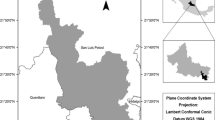Summary
Populations ofBecium homblei, a metal tolerant plant species, were found to exist in a number of isolated areas in which the soil conditions were very different. Corolla shape and seed weight which are regarded as relatively implastic characters in the species were examined from four populations and the results subjected to a statistical analysis. The greatest differences were found between those populations which grew in widely different soil types. Plants on heavy metal soils showed an overall reduction in flower size. It is suggested that the results indicate ecotypic variation between the populations.
Zusammenfassung
Populationen vonBecium homblei ciner Schwermetall toleranten Pflanzenart wurde in einigen isolierten Gebieten mit ganz verschiedenen Böden gefunden. Die Blütenform und das Gewicht der Samen als relativ nicht plastische Artenmerkmale wurden in vier Populationen studiert und die Resultate statistisch bearbeitet. Die größten Unterschiede ergaben sich zwischen Populationen ganz abweichender Bodentypen. Pflanzen von Schwermetall-Böden zeigten cine allgemeine Reduktion der Blütengröße. Es wird angenommen, daß die Resultate ökotypischen Variationen zwischen den Populationen entsprechen.
Similar content being viewed by others
References
BaileyN. T. J. 1959 — Statistical Methods in Biology. English Universities Press, London.
BradshawA. D. 1959 — Population differentiation inAgrostis tenuis.New Phytol. 59: 92–103.
CannonH. L. 1960 — Botanical prospecting for ore deposits.Science 132, 2427: 591–598.
GregoryR. P. &BradshawA. D. 1965 — Heavy metal tolerance in populations ofAgrostis tenuis and other grasses.New Phytol. 64: 131–143.
Howard-WilliamsC. 1970 a — The ecology ofBecium homblei in Central Africa with special reference to metalliferous soils.J. Ecol. 58: 745–763.
Howard-Williams, C. 1970 b — Environmental factors controlling the growth of plants in heavy metal soils. (In press).
JowettD. 1964 — Population studies on lead tolerantAgrostis tenuis.Evolution 18: 70–80.
McNeillyT. &BradshawA. D. 1967 — Evolutionary processes in populations ofAgrostis tenuis.Evolution 22: 108–118.
MalyugaD. P. 1964 — Biogeochemical Methods of Prospecting. Consultants Bureau. New York.
PalmbladI. G. 1968 — Competition in experimental populations of weeds with emphasis on regulation of population size.Ecology 49: 26–33.
Sokal, R. R. &Sneath, P. H. 1963 — Principles of Numerical Taxonomy W. H. Freeman and Co. San Francisco.
WildH. 1969 — Geobotanical anomalies in Rhodesia. 1 — The vegetation of copper bearing soils.Kirkia 7: 1–71.
WildH. &HeytingA. 1966 — An analysis of variation of leaf lengths ofBecium homblei andBecium obovatum.Bot. Notis. 119: 308–317.
Author information
Authors and Affiliations
Rights and permissions
About this article
Cite this article
Howard-Williams, C. Morphological variation between isolated populations of Becium homblei (De Wild.) duvign & plancke growing on heavy metal soils. Plant Ecol 23, 141–151 (1971). https://doi.org/10.1007/BF02326659
Issue Date:
DOI: https://doi.org/10.1007/BF02326659




